As a busy working mom, finding time to cook wholesome meals for my family can be challenging. But when I get a craving for the crispy, melty goodness of Japanese katsu, I make it happen! My cheese donkatsu is a family favorite that brings me right back to carefree summers as a kid in Osaka.
Slipping those golden cutlets onto my plate transports me through time and space. The nostalgia of that first, impatient bite before my mouth meets with oozing, stretchy cheese…pure bliss! Now as a parent myself, I love sharing this dish from my heritage with my own children. Preparing it together gives us a chance to connect while creating yummy memories.
The crispy panko crust with its hidden cache of cheese is irresistible to kids and adults alike. My little ones have come to eagerly anticipate this treat. They get so excited to dip the cutlets in tangy tonkatsu sauce themselves. The smiles on their round faces when the cheese starts flowing out makes all the effort so rewarding.
When life gets too rushed, this cheese donkatsu recipe helps me slow down. I find peace in the methodical process of breading and frying. With each sizzle in the oil, I feel centered again. Though my days now look different than those carefree summers of childhood, this dish keeps me grounded. It’s a taste of home no matter how hectic life becomes.
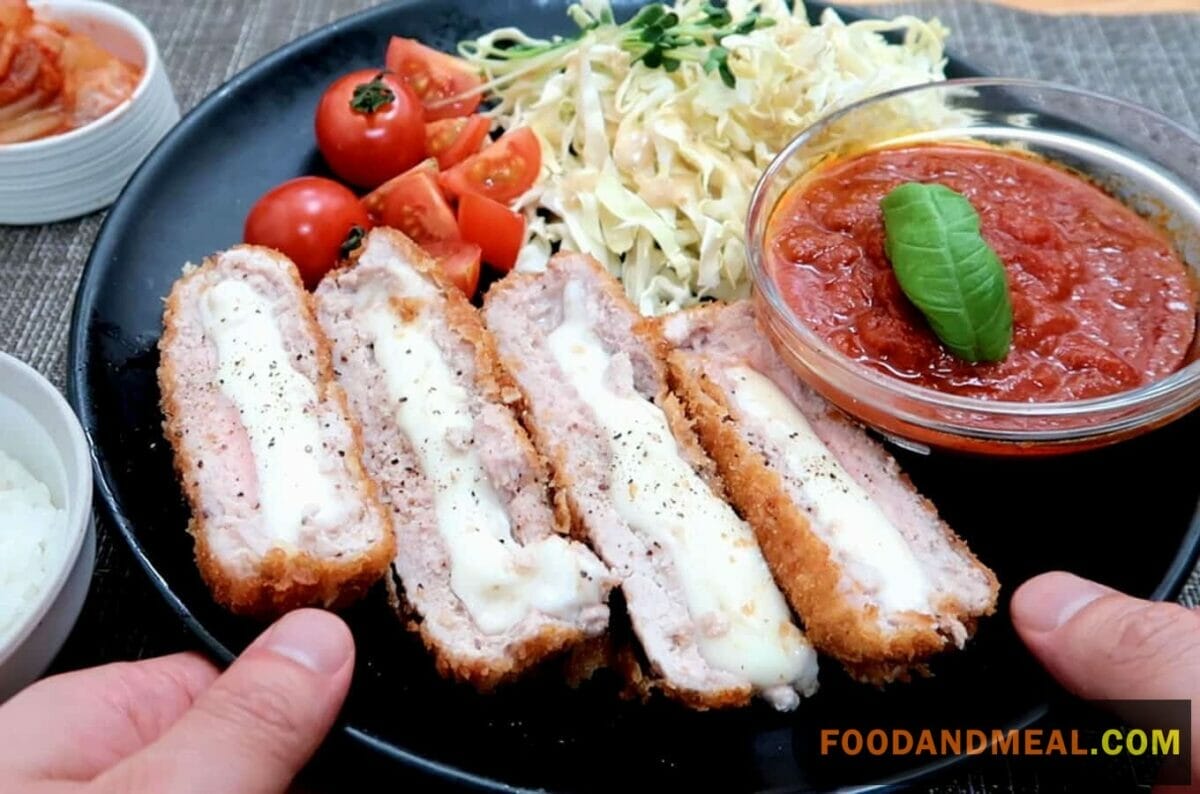
Cheese Donkatsu Recipe
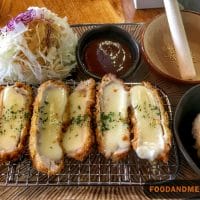
CHEESE DONKATSU
Equipment
Ingredients
- 2 pork cutlets
- 1 egg, beaten
- 1/3 cup all-purpose flour
- 1/3 cup panko bread crumbs
- Vegetable oil for deep-frying
- 1/3 cup grated mozzarella cheese
- 2 tablespoons donkatsu sauce, for drizzling
Instructions
- Pound the pork cutlets with a mallet or the back of a wooden spoon to make them as flat and thin as you can. It’s easy to do this between two sheets of parchment paper, plastic wrap, or inside a zip-top plastic bag.
- Put the egg and flour into two separate shallow bowls. Spread the panko bread crumbs on a clean cutting board or on a piece of parchment paper.
- Dip the pork cutlets into the egg and then dredge them in the flour. Dip them into the egg again and then coat them thoroughly with the panko.
- In a wok or heavy saucepan, heat 1 inch of vegetable oil over high heat. When the oil is very hot, add the cutlets and cook, turning once, until golden brown on both sides, about 3 minutes per side. Transfer the cutlets to a serving platter, and immediately sprinkle the mozzarella cheese over the top. Tent with foil or a pot lid to melt the cheese.
- To serve, drizzle with donkatsu sauce.
Video
Notes
INGREDIENT TIP: Donkatsu sauce is Japanese-style Worcestershire sauce, and is made of unique blend of vegetables, Worcestershire sauce, and sugar. You can find this at Japanese and Korean markets and online. Mix equal parts ketchup and Worcestershire sauce at home if you don’t have donkatsu sauce.
VARIATION TIP: For a change, serve this with Korean curry sauce instead of donkatsu sauce.
Nutrition
© Food And Meal
This website provides approximate nutrition information for convenience and as a courtesy only. Nutrition data is gathered primarily from the Spoonacular Database, whenever available, or otherwise other online calculators.
Cooking Tips
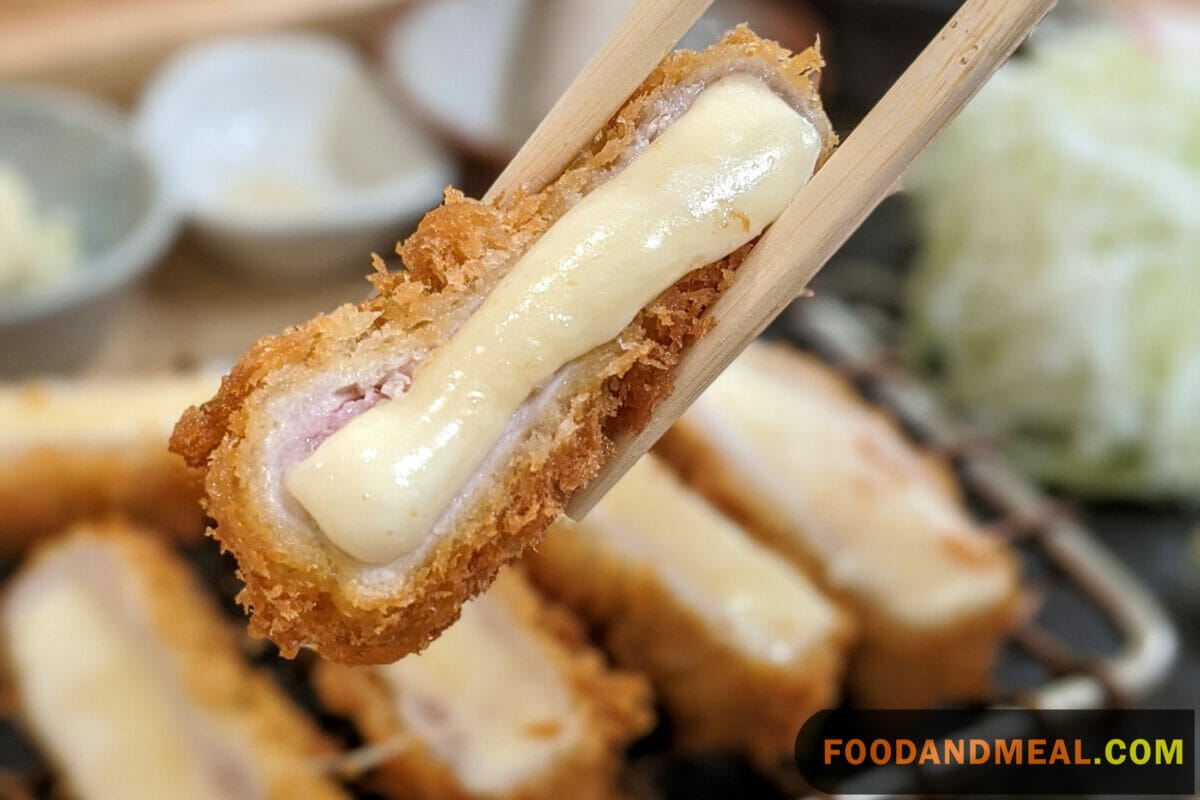
The cheese katsu is a pork cutlet rolled with mozzarella cheese inside and coated with a layer of panko than air fried. To prevent the cheese from leaking out during cooking, it’s important to seal the pork cutlet tightly around the cheese and chill it before breading. Using low-moisture mozzarella also helps prevent oozing. Additionally, frying the katsu from partially frozen helps set the bread so the cheese doesn’t leak out.
When frying, the oil should be heated to 350-360°F and the katsu should fry until it reaches an internal temperature of 145°F. Neutral oils like canola or vegetable oil work well. To ensure even cooking, avoid overcrowding the pot.
Tonkatsu is served pre-sliced with rice, shredded cabbage, and miso soup. Donkatsu is served whole with a knife and fork.Donkatsu uses thicker cuts than traditional Japanese tonkatsu. Both use pork, but donkatsu can also be made with chicken or beef.
The katsu sauce uses ketchup, Worcestershire sauce, soy sauce and Dijon mustard. It does not require cooking.
For the pork, rosu (loin) cut is juicier while hire (filet) is leaner. Cornstarch makes the bread crispier than flour.
Serving Suggestions
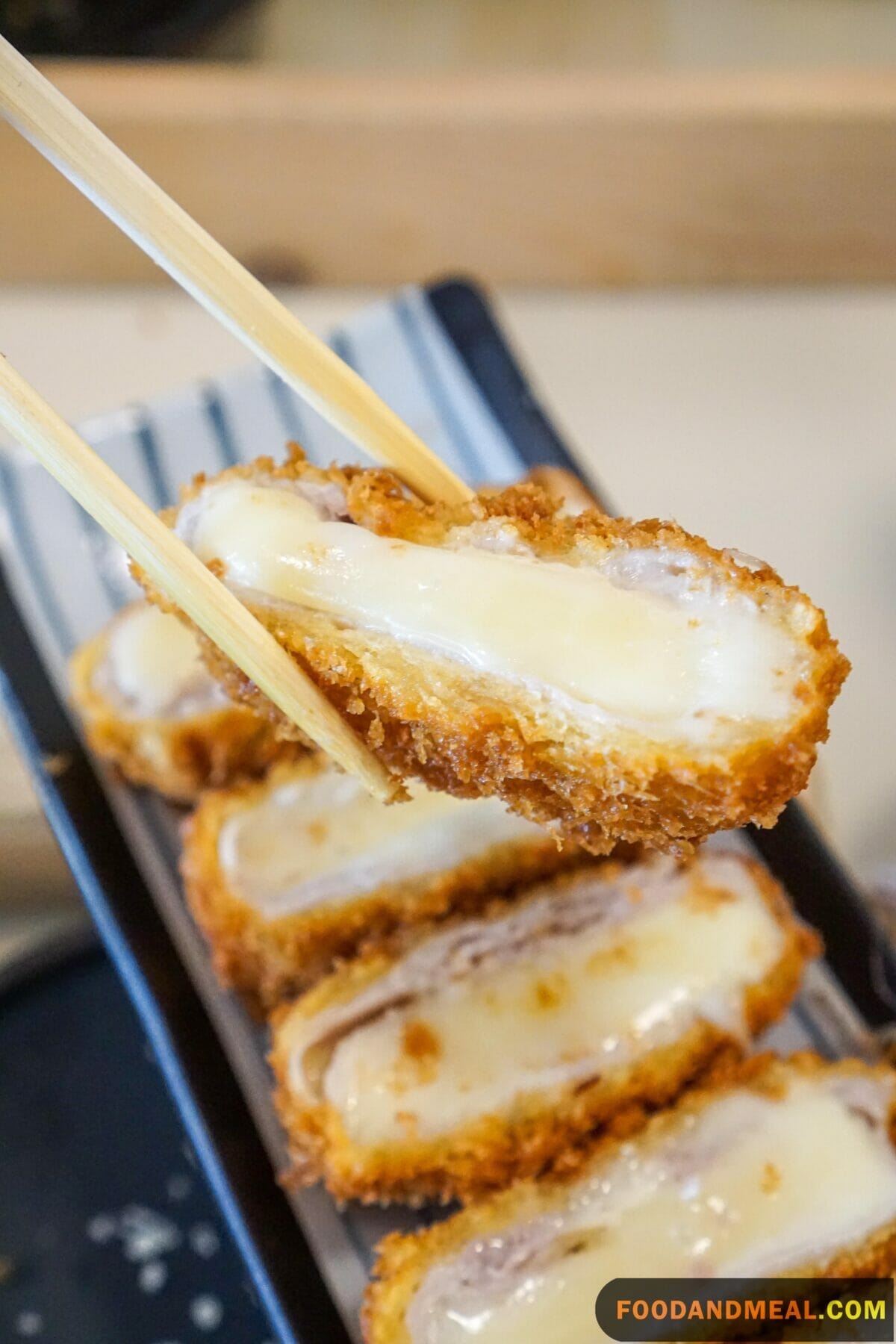
For a fusion experience, pair the Cheese Donkatsu with Japanese curry rice, creating a comforting and richly flavored meal. Alternatively, transform it into a unique ramen topping, infusing your bowl with the delightful combination of crispy textures and cheesy goodness. Embrace a sandwich creation, where the Cheese Donkatsu takes center stage between slices of soft bread, complemented by your favorite condiments and veggies. For a lighter option, integrate this savory treat into a fresh salad bowl, offering a satisfying crunch alongside vibrant greens. Elevate social gatherings with a Cheese Donkatsu snack platter, complete with an array of dipping sauces. Take a bold leap by incorporating Cheese Donkatsu into a burger, turning a classic into a cheesy delight. Thread bite-sized cubes onto skewers for a convenient and appetizing party option. Finally, craft a hearty rice bowl by placing slices of Cheese Donkatsu atop steamed rice, creating a satisfying fusion of flavors and textures.
FAQs of Cheese Donkatsu
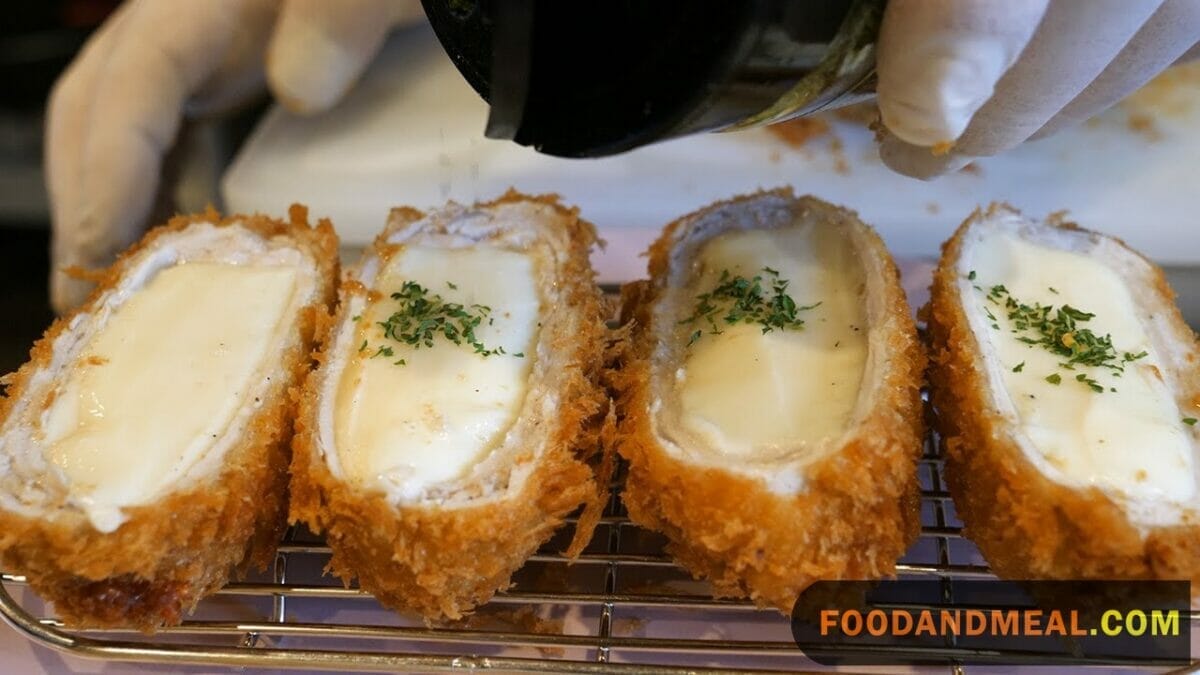
- What is Donkatsu made of? Donkatsu, also known as Tonkatsu, is a popular Japanese dish made primarily of breaded and deep-fried pork cutlets. The pork is typically coated in flour, dipped in beaten eggs, and then covered with panko breadcrumbs before frying until golden brown. The result is a crispy exterior with a tender and flavorful pork interior.
- What is the difference between tonkatsu and donkatsu? Tonkatsu and Donkatsu refer to the same dish – breaded and deep-fried pork cutlets. The difference lies in the pronunciation. While “Ton” is Japanese for pork, “Don” is an alternative reading. Essentially, they are the same delicious dish.
- What is cheese katsu made of? Cheese Katsu, or Cheese Donkatsu, is a variation of the classic Tonkatsu where the pork cutlet is filled with a layer of gooey cheese. The preparation involves sandwiching cheese between two thin slices of pork, breading the cutlet, and frying it until golden brown. This adds a delightful cheesy surprise to the traditional crispy pork cutlet.
- What is the difference between tonkatsu and gyukatsu? The main difference between Tonkatsu and Gyukatsu lies in the meat used. Tonkatsu is made with pork cutlets, while Gyukatsu features beef cutlets. Both are breaded, deep-fried, and served with a tonkatsu sauce, but the choice between them depends on whether you prefer the porky richness of Tonkatsu or the beefy goodness of Gyukatsu.
- Can I use chicken instead of pork for Cheese Donkatsu? Absolutely! Chicken breast can be a delicious alternative, offering a lighter flavor.
- Is there a vegetarian version of Cheese Donkatsu? Indeed! Swap the meat with a firm tofu cutlet or a portobello mushroom cap for a satisfying vegetarian twist.
- Can I prepare the cutlets in advance? Absolutely. Bread and fry the cutlets, then reheat them in an oven to maintain their crispiness.
- What oil should I use for frying? Opt for neutral oils with a high smoke point, such as vegetable or canola oil.
- Can I freeze Cheese Donkatsu for later? Yes, you can. Freeze the breaded but uncooked cutlets on a baking sheet, then transfer to a freezer-safe bag. Fry them directly from frozen when needed.
Conclusion
In conclusion, I hope this cheese donkatsu recipe inspires you to reconnect with your own food memories and family traditions. At Food and Meal, we believe cooking is so much more than just preparing sustenance – it’s an act of love.
As you gently roll up the pork cutlet around that molten cheese filling, recall the aromas from your grandmother’s kitchen or the joy of cooking with your little ones. Let this dish wrap your family in nostalgic comfort. And if your donkatsu doesn’t turn out perfectly crispy the first try, laugh it off! The real magic is in the hands-on process and time together over the stove.
For more recipes to make lasting food memories, be sure to check Food and Meal regularly. Our team pours our hearts into every recipe we develop, hoping to spark that same magical feeling for your family. Thanks for reading, and happy cooking from our kitchen to yours!
Hi! I'm Nazia of ‘Nazia Cooks’, a self-taught baker and cook residing in Chennai. Rooted in the rich South Indian culinary landscape, my palate has expanded to embrace global flavors. I revel in crafting fusion dishes, melding traditions to birth unique tastes.





